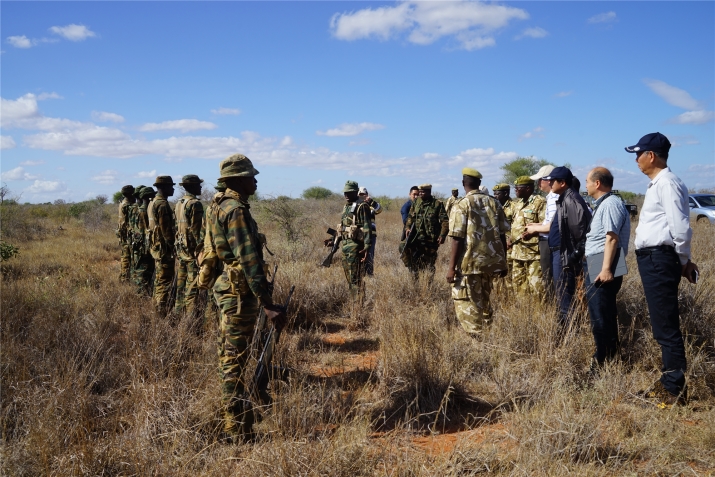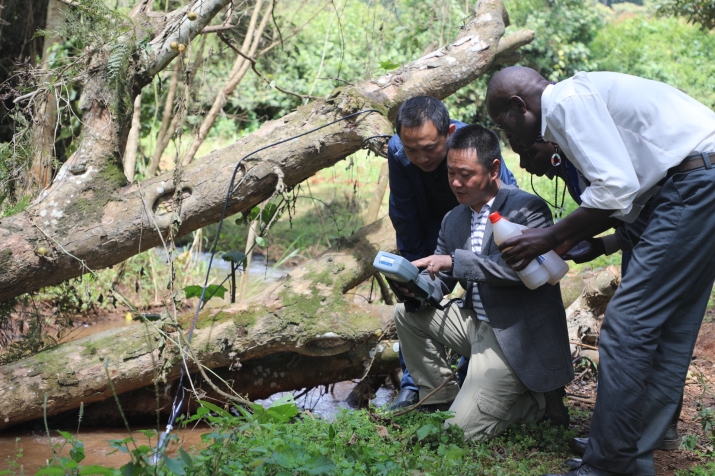|
||||||||||
| Home Nation World Business Opinion Lifestyle ChinAfrica Multimedia Columnists Documents Special Reports |
|
||||||||||
| Home Nation World Business Opinion Lifestyle ChinAfrica Multimedia Columnists Documents Special Reports |
| ChinAfrica |
| Collaborative Innovation |
| Sino-Africa Joint Research Center aims to seek solutions for Africa and beyond |
| By Hu Fan | VOL.11 May ·2019-05-13 |

To better protect rhinos, as well as other wildlife, Kenya established the Ministry of Tourism and Wildlife in 2018. The government department has adopted strict protection measures, with armed police guarding rhinos 24 hours a day. However, wildlife protection in Kenya relies heavily on patrols, which is laborious and inefficient.
Now they have got another option to fulfill their missions - the use of cutting-edge technologies, with drones monitoring rhinos from the sky, short-wave radio stations detecting poacher movements, and handheld thermal imagers observing animals from distance in the night. These are part of a system that will be deployed in Tsavo, Kenya's largest national park. With the system, it is possible to identify poachers within 2 minutes after their entry and to monitor the whole park from a command center.
This high-tech anti-poaching system is tailored for Kenya by the Sino-African Joint Research Center (SAJOREC), headquartered in Nairobi, Kenya. Established in 2013, the center is an important part of China-Africa cooperation and was included in the action plans of both the Johannesburg Summit and Beijing Summit of the Forum on China-Africa Cooperation, hold in 2015 and 2018 respectively.

Scientists of the SAJOREC in a field investigation (ZHANG YU)
Integrated solution
The system has fully developed in China and is accepted by the Chinese Academy of Sciences (CAS), the supervising body of the center, according to Professor Wang Qingfeng, Director of the center. The microwave sensors of the detection systems can perform a 360-degree scan every minute, covering a range of 10 km. Once an abnormality is detected, the data will be transmitted to the adjacent optoelectronic devices. Then a high-definition image will appear on the screen of the command center.
The system is also equipped with drones featuring carbon fiber bones and cameras, which can fly at the height of up to 1 km and withstand strong winds. The drones are capable of making short-wave radio transmission over an area of 100 km without the need of base stations. "When China's Beidou Navigation Satellite System covers Africa in the future, the anti-poaching system can be upgraded to directly locate the animals," Wang told ChinAfrica.
According to Kenyan authorities, technical assistance has been provided for Africa's wildlife protection by developed countries and international organizations, but the effect is limited due to the lack of an overall design at the national level. The variations in technologies and devices from different sources make it difficult for long-term use and maintenance.
The center is able to address this problem because unified moves and integration of resources are made possible with the coordination of various Chinese institutes under the Belt and Road Initiative. "Our advantage is that we combined the technical strengths of the various research institutes that make up the center," said Wang.
The SAJOREC is conducted by the Wuhan Botanical Garden, an affiliate to CAS, located in central China's Hubei Province, and joined by 18 other Chinese institutes including the Institute of Zoology, the Institute of Botany and the Shanghai Institute of Advanced Studies, also affiliated to CAS. Its areas of expertise include zoology, botany, microbiology, molecular biology, agriculture, remote sensing, and information technology.
In Africa, the center cooperates with 15 African institutions including Jomo Kenyatta University of Agriculture and Technology (JKUAT), and conducts research in some of the areas that are most needed in Africa, including agricultural technology, epidemiological control and conservation of biodiversity.
Sustainable cooperation
In 2013, 11 Kenyan students arrived at the Wuhan Botanical Garden and became the first batch of students of SAJOREC. They had just finished a year of preparatory courses at the University of Chinese Academy of Sciences (UCAS) and came to the center and other research institutes affiliated to CAS for further study. Three years later, six of them continued their studies in China in SAJOREC's doctoral programs, and five returned to Africa to teach at universities or conduct research and development at companies.
By 2019, the center has recruited 149 African students, from Kenya and other African countries, including 122 for master's programs and 27 for doctoral programs.
Wang said the center now enrolls 30-35 students each year for a wider range of majors including zoology, microbiology, molecular biology, agriculture, and remote sensing. It is the aim of the center to enroll students to study and research in fields for which there is high demand in their own country. For better education, a dual-tutor system is adopted for these programs, with one Chinese tutor and one African tutor for each student.
These programs are supported by various scholarships in China. For example, the UCAS provides 120 scholarships annually for young students from the countries along the Belt and Road routes, which covers tuition fees and living allowances.
In addition to recruiting students from Africa to study in China, the center also recruits Chinese students interested in doing collaborative research with Africa. Among them, Zhou Yadong, a doctoral student of Wang, spent years doing field research in Mount Kenya with Kenyan colleagues of the National Museums of Kenya and discovered several new plant species there.
"The training of these students, including African students and Chinese students interested in Africa, helps create a talent pool for future China-Africa cooperation in science and technology and ensures the sustainability of our cooperation. It is also beneficial for the development of the center in the long run," Wang said.
Another mission of the center is to carry out training courses in response to the development needs of Africa. This type of training course covers a wider range of topics and can benefit more people.
From December 3 to 10, 2018, the center held a training course in its headquarters in Kenya jointly with JKUAT, which was attended by 42 African students from 10 countries including Kenya, Tanzania, Ethiopia, Egypt and Madagascar.
So far, the center has held more than 15 international trainings and seminars and trained more than 200 people.
New horizon
Now the SAJOREC is moving to a new front: building a cooperative platform for innovations between China and Africa.
In February, a delegation of the Ministry of Education of Kenya arrived in China for negotiations with CAS and the Department of Science and Technology of Hubei Province, where the Wuhan Botanical Garden is located. The intent to build the platform was agreed upon and preparations are underway.
According to the department, activities of the platform will include demonstration of innovations, intellectual property
sharing, transfer of technology, practical application of technological achievements and incubation of entrepreneurship.
In contrast to the tasks of the center, which are focused on fundamental research and people's livelihood, the new platform will facilitate technology transfer to Africa and provide assistance to young Africans to start their own businesses, according to Wang.
(Comments to hufan@chinafrica.cn)
| About Us | Contact Us | Advertise with Us | Subscribe |
| Copyright Beijing Review All rights reserved 京ICP备08005356号-5 京公网安备110102005860号 |